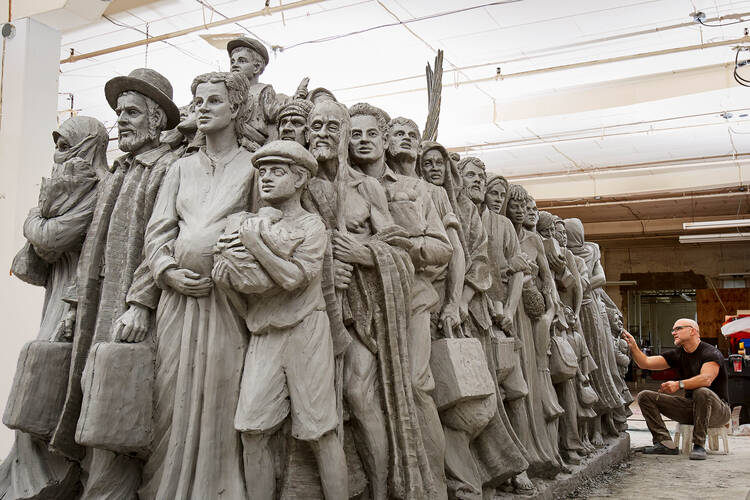Ten years ago, Regis College in Toronto took a chance on an art piece by the Catholic sculptor Timothy Schmalz. Its design was simple: a metal park bench, with a man lying huddled under blankets and his feet sticking out to reveal gaping wounds. At the time, the artist was struggling to find a place to put his “Homeless Jesus.”
By the end of that year, Mr. Schmalz was giving a small model of the statue to Pope Francis, and today his sculptures line the streets and squares of cities across the world. Schmalz gives all due credit to the source material.
“People are hungry for the Scripture. People are hungry for Christianity. It just has to be presented in a way that people can see it,” he said in an interview with America.
In March, Mr. Schmalz came to St. Patrick’s Cathedral in New York on the saint’s feast day for the installation of his latest sculpture, entitled “Let the Oppressed Go Free.” A small model, similar to one displayed in the Vatican last year, will reside in St. Patrick’s to serve as a statement on human trafficking.
Mr. Schmalz has been sculpting for over 30 years, in both the religious and public spheres. When it comes to his Catholic art, he said he has a particular agenda: He wants to see art about more than just the same few scenes of the New Testament.
“There’s so many wonderful poetic gems within Scripture that have not been interpreted into visual artwork yet,” he said. “And it’s interesting, because you have 2,000 years of Christianity; why hasn’t the whole Bible been represented in artwork?”
In “Let the Oppressed Go Free,” St. Josephine stands and looks ahead defiantly, her hand grasping a trapdoor and heaving it open. From below march a crowd of enslaved men, women and children who are escaping from their captivity.
This mission inspired “Let the Oppressed Go Free,” which takes its title from Isaiah 50:6. For this piece on human trafficking, the artist looked to St. Josephine Margaret Bakhita, a Daju saint from Darfur, in modern-day Sudan. Born around 1849, St. Josephine spent much of her young life enslaved and traded among owners, frequently beaten and abused. Purchased by an Italian family, she encountered the Canossian Sisters in Venice and converted to Catholicism before securing her freedom.
In “Let the Oppressed Go Free,” St. Josephine stands and looks ahead defiantly, her hand grasping a trapdoor and heaving it open. From below march a crowd of enslaved men, women and children who are escaping from their captivity. Mr. Schmalz emphasized that this is not a joyful scene but a solemn one, a reminder of the fight to come rather than a celebration of victory.
Schmalz tends to be a perfectionist—he said that he created a different model for “Let the Oppressed Go Free” that did not include the trapdoor, but once the new idea came to him, he physically destroyed the old model, “so I never had the chance of going back to it.” Work on his projects tends to span years.
He said that for an upcoming project, he has been commissioned to create a monumental Stations of the Cross for the Basilica of the National Shrine of Mary, Queen of the Universe, in Orlando, Fla. His vision is to include hidden nods to the parables of the New Testament in each scene, from a Pharisee dressed in fine robes to a Roman centurion on his horse.
For an artist whose work has stood on every continent but Antarctica, he had almost no hesitation when describing the most memorable moment of his career. After the success of “Homeless Jesus,” Schmalz was invited to create another sculpture by Michael Czerny, S.J., then undersecretary of the Migrants and Refugees Section of the Vatican’s Dicastery for the Promotion of Integral Human Development. Father Czerny has since then become the dicastery’s prefect and a cardinal.
For this sculpture, Father Czerny asked for a reflection on the plight of immigrants, which prompted Mr. Schmalz to consider another Bible passage: “Do not neglect to show hospitality to strangers, for thereby some have entertained angels unawares” (Heb 13:2).
Mr. Schmalz got to work on a sculpture based on a passage from Hebrews, which he named “Angels Unawares,” which features a crowd of migrants from various ethnic, racial and religious backgrounds.
Mr. Schmalz got to work on a sculpture based on this passage, which he named “Angels Unawares,” which features a crowd of migrants from various ethnic, racial and religious backgrounds. Each unique face wears a different expression—some of hope, others of apprehension.
From the center of the huddled masses emerges a pair of wings, hovering just above the bodies.
Mr. Schmalz said his most memorable moment as an artist was watching that sculpture lowered into St. Peter’s Square in the Vatican on the 105th World Day of Migrants and Refugees, which was Sept. 29, 2019.
This installation marked the first time in four centuries—since the Baroque work of Gian Lorenzo Bernini—that St. Peter’s Square gained a new piece of art.
The thread that ties “Angels Unawares” and “Let the Oppressed Go Free” together, Mr. Schmalz said, is the sense of dedication for a marginalized and forgotten group. After seeing statues of famous politicians or athletes, he said he feels honored to pay tribute to refugees and victims of trafficking in such an “auspicious way.”
“These people aren’t even acknowledged at all, let alone have a bronze sculpture made of them,” he said. “It just brings up a very powerful presence [for] them.”
The first full-sized model of “Let the Oppressed Go Free” will be installed at the Basilica of the National Shrine of the Immaculate Conception in Washington, D.C., after a cross-country tour this summer. Soon after that, St. Joseph’s Oratory in Canada and the tomb of St. Josephine in Italy will receive their own copies.
And as for Mr. Schmalz, he gave no indication of slowing down.
“I have this kind of Platonic idea that these amazing masterpieces are already in heaven. And it’s my job to pull them down,” he said.







